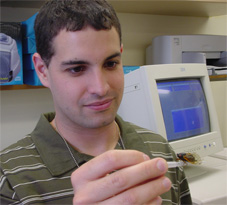Cicadas Help in Study of Lou Gehrig's Disease (web article)
Researchers at the Johns Hopkins Bloomberg School of Public Health are studying the cicada to better understand the mutated gene that causes amyotrophic lateral sclerosis (ALS), also known a Lou Gehrig’s disease. Val Culotta, PhD, a professor in the School’s Department of Environmental Health Sciences, has been conducting a comparative biology study to analyze the gene known as superoxide dismutase, or SOD1, in diverse organisms to better understand how the human gene works. The Magicicadas brood X, which only appears for a few weeks every 17 years, provided a unique opportunity to study the gene in an insect.

Technician Mark Carroll examines
a cicada in the lab.
The SOD1 is a highly conserved gene that is found in all organisms that are exposed to oxygen. One of its functions is to protect cells from the toxicity of oxygen. To do so, SOD1 needs to bind copper. One of the theories for how mutations in SOD1 cause ALS involves how the copper ion binds to SOD1, which Dr. Culotta has studied extensively.
“We originally thought there is only one way that SOD1 could bind copper, but when we did a comparison of human and yeast SOD1, we found that there are at least two ways that SOD1 can acquire copper. The human protein has evolved to use both pathways, whereas the yeast protein can only use one pathway. Insects may use a completely novel method to bind copper,” said Dr. Culotta. “Our plan was to study the insect gene from mosquitoes or fruit flies, but it would be nice to have an additional data point to add to our collection of insect genes. One of our lab technicians, Mark Carroll, suggested taking advantage of this once in 17-year opportunity to study the brood X cicadas, which are so plentiful at this time. Our goal is to clone the first gene of this type from all three species of brood X of the Magicicadas. This technology certainly didn't exist 17 years ago,” she added.
According to Dr. Culotta, the cicadas offered a unique model for studying SOD1, because they spend 17 years underground in a low-oxygen environment before emerging in the oxygen-rich air above ground. Carroll helped develop a procedure for studying SOD1 from live cicadas. He found that the cicadas have high levels of the protein to protect their cells from the changes in oxygen environment.
To learn more about cicadas, Dr. Culotta and Carroll consulted with John Cooley, PhD, a research associate with the Department of Ecology and Evolution at the University of Connecticut and an expert on Magicicadas evolution. He provided valuable assistance on how to capture the insects in the wild, keep them alive and identify the three different species and how to isolate RNA and DNA for gene cloning experiments.
“It was pretty interesting working with the cicadas. Every once in a while they would get out or I would find one in the hall,” said Carroll.
The researchers hope that their study of the cicadas could help design new ways to control copper binding to the ALS mutant SOD1 molecules in humans. In addition, they hope to learn if the cicada, because of its very unusual life cycle, has evolved with a completely novel way of capturing copper for SOD1 to cope with the high level of oxidative stress. This information may also be useful to ultimately design methods for controlling copper insertion into human SOD1 and preventing ALS.--Tim Parsons
Public Affairs media contacts for the Johns Hopkins Bloomberg School of Public Health: Tim Parsons or Kenna Lowe at 410-955-6878 or paffairs@jhsph.edu.